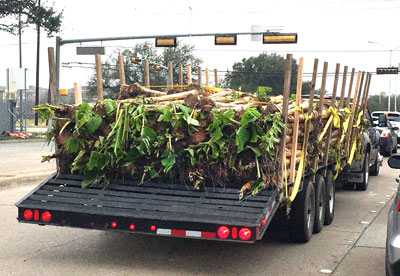Yes, We Have Some Bananas!

Photo: I pulled up to a stoplight on my way home last Sunday. This load of a thousand banana plants was sitting alongside me. That’s evidence: it’s time to get planting.
One of the most common questions I’m asked is “How can I create a topical look in my backyard.”
I always say that we want to use widely varying contrasts of leaf sizes and textures, and bananas come first to mind. They aren’t difficult as long as you get them rooted into the ground once the soil starts to warm, and then keep them moist and well fed with a high-nitrogen fertilizer.
I was a little surprised to see this trailer loaded with transplants heading through Plano last Sunday. It doesn’t seem like the soil would be quite warm enough just yet. Of course, South Texans are weeks ahead and ready to plant them, so if that’s where you are, have at ‘em!
There are several types of bananas available in the nursery trade. This is the common one, but several are dwarf, and some have boldly burgundy foliage.

Photo: This batch of bananas was produced on a plant in the DFW area last fall. Unfortunately the photo was taken at the end of October. I don’t think these ever had a chance to mature.
But will they bear fruit? Yes, but it very likely will not mature in the northern half of Texas before the plants freeze to the ground in the winter. In South Texas, where you have winters without any freezes at all (2015-2016, but certainly not 2016-2017!), your fate may be different.
Wind whips banana leaves into a frenzy – actually into shreds. But that doesn’t hurt the plants. It just gives them more moving parts to wave in the breeze.
Finally, looking ahead to next winter, let your banana plant freeze to the ground. Wait a day or two, then trim off all the frozen tissues after they “melt” to the ground and dry out. Mulch over the plants’ crowns with fallen tree leaves to moderate the rates of soil temperature changes over the winter.
